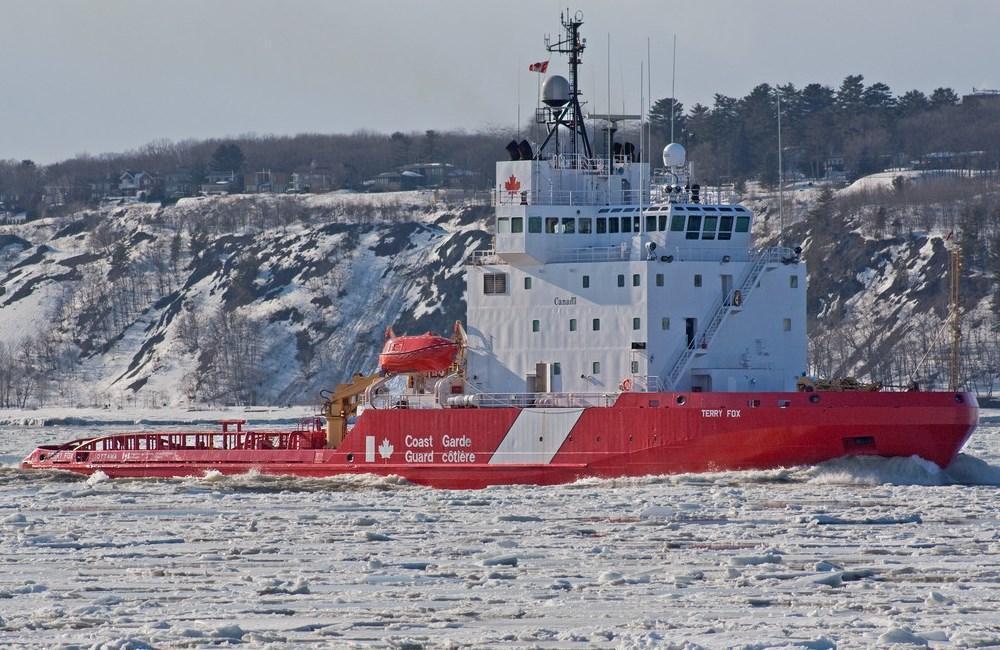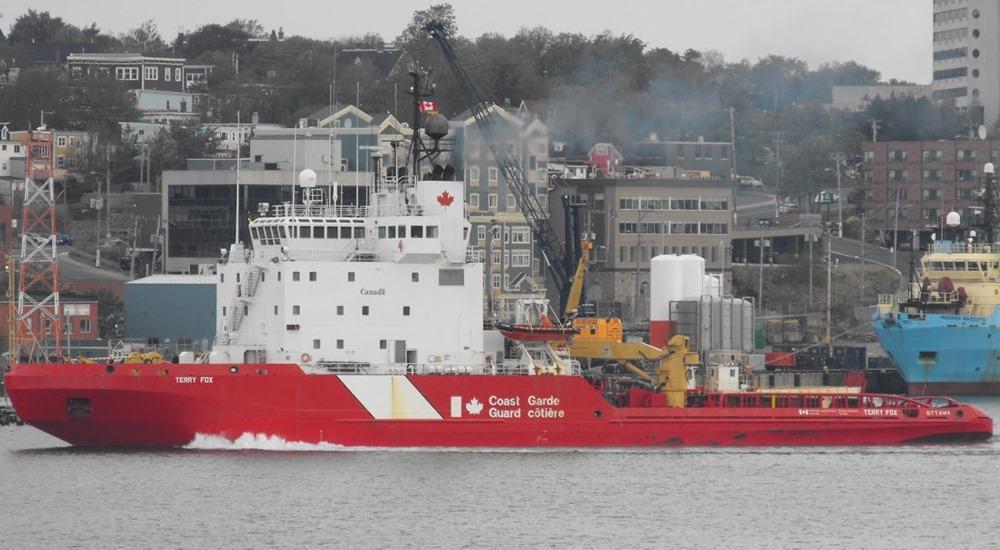CCGS Terry Fox icebreaker
CCGS Terry Fox icebreaker last position
The last location of CCGS Terry Fox icebreaker is in Great Lakes (coordinates 43.21420 N / -79.20955 W) cruising en route to PORT WELLER. The AIS position was last reported 1 year ago.
Current PositionSpecifications of CCGS Terry Fox icebreaker
| Year of build | 1983 / Age: 42 |
| Flag state | Canada |
| Builder | Burrard-Yarrows Corporation (North Vancouver, Canada) |
| Class | Arctic Class 4 Icebreaker |
| Building cost | CAD 79 million (USD 97M) |
| Engines (power) | Stork-Werkspoor (17.3 MW / 23200 hp) |
| Propulsion power | 14.3 MW / 19177 hp |
| Speed | 16 kn / 30 km/h / 18 mph |
| Length (LOA) | 88 m / 289 ft |
| Beam (width) | 18 m / 59 ft |
| Gross Tonnage | 4234 gt |
| Passengers | 10 |
| Crew | 24 |
| Sister-ships | Arctic Kalvik (Vladimir Ignatyuk icebreaker) |
| Owner | Canada |
| Operator | Canadian Coast Guard |
CCGS Terry Fox icebreaker Review
Review of CCGS Terry Fox icebreaker
The 1983-built CCGS Terry Fox is a Canadian Arctic icebreaker. "CCGS" stands for "Canadian Coast Guard ship". The icebreaking vessel (also classified as Anchor Handling Vessel) was commissioned by/started operations for the Canadian Coast Guard in 1991 and changed ownership (from BeauDril Ltd to CCGS) in 1993.
Currently, the ship is assigned to/homeported in CCG Base Southside in St Johns (Newfoundland Island) to serve Canada's Newfoundland and Labrador province.
Note: CCGS Terry Fox is currently scheduled for decommissioning in 2032, two years after the newbuild CCGS John G Diefenbaker starts operations for the Canadian Coast Guard. The ship was initially slated for decommissioning in 2020, but these plans were revised/postponed and instead, the icebreaker will undergo an 18-month drydock refit/modernization (2023-2025) to extend its service life through 2032.

The heavy icebreaker Terry Fox was designed to serve as an escort to oil tankers through the Canadian Arctic territories.
The vessel (IMO number 8127799) is currently Canada-flagged (MMSI 316122000) and registered in Vancouver BC.
This class of icebreakers is classified as a "heavy tug" (supply vessel). Besides escorting ships, they also support offshore oil rigs in ice-rich waters. The ship's bow is spoon-shaped, allowing it to ride up on packed ice in order to break it. The icebreaker is "Arctic Class 4" certified, which means ice capacity up to 1,8 m (6 ft).
CCGS Terry Fox icebreaker itinerary program includes operations in Gulf of St Lawrence (during winter) and in the eastern Canadian Arctic territories (during summer). The ship's previous assignment was at CCG Base Dartmouth (Nova Scotia) until 2008. The ship will be decommissioned in 2021-2022, right after the commissioning of the new CCGS John G Diefenbaker (2021-2022).
CCGS Terry Fox icebreaker vessel details
The Terry Fox ship is of the same design as (sistership to) the Russia-owned icebreaker Vladimir Ignatyuk (Arctic Kalvik).

The vessel has 1 dining room, Sauna, no swimming pool, no elevator, no helipad (helicopter deck).
- Max Draught: 8,3 m (27 ft)
- DWT Deadweight tonnage: 2113 tons
- Displacement tonnage: 7100 tons (7200 tons when fully loaded)
- Radars: 2x "Raccal ", 1x "Furuno 1411 Mk II" (color)
- Range (fuel): 3560 km (2210 mi)
- Endurance (supplies): 58 days
- Ice-class: Arctic 4
- ice-breaking capacity: 1,2 m (4 ft) at speed 3 Kn / 5,5 kph / 3,5 mph
- Diesel fuel storage: 1920 m3 (67,770 ft3)
The powerplant is based on 4x Stork-Werkspoor diesel engines (model 8TM410) driving 2 shafts - total output 17,3MV, (23200 hp). Electric power is provided by two "Caterpillar 3512" diesel generators plus one "Caterpillar 3406" backup generator.
The propulsion system is based on two controllable pitch propellers and two thrusters (1 bow, 1 stern).
The icebreaker carries a tow rope (length 1,5 km / 0,93 mi).
Of the 24 crew, 10 are officers.
For more information (including service history) see the ship's Wiki section.
Note: In the case of poor AIS coverage, tracking the vessel's current location will be impossible. You can see CruiseMapper's list of all icebreakers and ice-breaking research ships in the "itinerary" section of our Icebreakers hub. All states and their fleets are listed there.
Other Canadian Coast Guard cruise ships
CCGS Terry Fox icebreaker Wiki
The vessel was ordered on December 1, 1979, by BeauDril Ltd (an oil and gas exploration corporation, a subsidiary of Gulf Canada Resources). In the 1980s, BeauDril invested into building four icebreaking vessels plus one arctic offshore platform (Kulluk). The company operated in the Beaufort Sea (off Herschel Island) from its homebase at Tuktoyaktuk (NT Canada) near Mackenzie River's delta.
Gulf Canada Resources Ltd (1944-founded as Canadian Gulf Oil/1969-renamed Gulf Oil Canada/2001-renamed Gulf Canada Resources) merged in 1956 with the British American Oil Company (1906-1969/became Gulf Oil Canada Ltd). In 2001, Gulf Canada Resources was acquired by Conoco Inc (1875-founded/2002-defunct) and renamed Conoco Canada Resources Ltd. As a gasoline brand, since 2012, Conoco is owned by the Phillips 66 Company (1927-founded, Houston, Texas-based company that owns and operates oil and gas filling stations in the USA and Europe/Austria, Denmark, Germany, Sweden, UK).
The Terry Fox icebreaker's construction/assembly started with the keel-laying on June 15, 1982. The ship was launched/floated out from drydock on April 23, 1983, and delivered to BeauDril on September 16.
The shipbuilder is Burrard Dry Dock Co Ltd (1906-founded as Versatile Pacific Shipyards/1925-renamed Burrard Dry Dock/1994-acquired by Victoria Shipyard, now owned by Seaspan Marine Corporation) in North Vancouver. The company was part of Burrard-Yarrows Corporation (in 1985 renamed Versatile Pacific Shipyards Inc). During both world wars (1914-18 and 1939-45) Burrard Dry Dock built/refitted hundreds of warships for the British and Canadian Royal Navies.
In the period 1983-1990, Terry Fox supported BeauDril's drilling platforms in the Beaufort Sea (19 wells total). The Canadian Coast Guard signed a 2-year lease deal with BeauDril on November 1, 1991, using Terry Fox as a replacement for CCGS John A. MacDonald (1960-built/1995-scrapped) as CCGS Louis S. St-Laurent (1969-built) was in drydock (1988–1993) for an extensive refit/modernization. After the leasing period, Terry Fox was acquired (from Gulf Canada Resources Ltd) and officially commissioned by the CCG on November 1, 1993.
Terry Fox was among the CCG ships deployed in June 2023 to search for OceanGate's Titan submersible off Newfoundland's coast. The submarine exploded on June 18th during an expedition to the RMS Titanic's wreck. On the submarine were Stockton Rush (OceanGate's CEO), Paul-Henri Nargeolet (Titanic expert), George Hamish Livingston Harding (UAE-based British businessman, pilot, adventurer), Shahzada Dawood (Pakistani-British businessman/Engro Corporation, Dawood Hercules Corporation) and his son Suleman Dawood.

